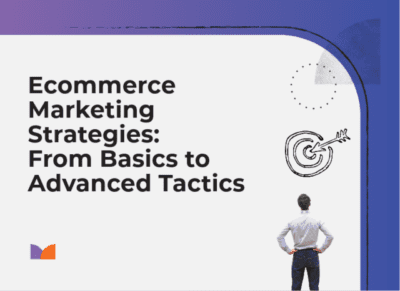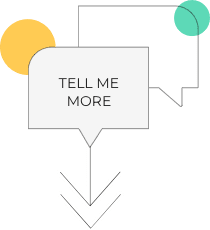
Ecommerce Marketing Strategies: From Basics to Advanced Tactics
Ecommerce marketing is a winding road that follows shoppers from that first “aha moment” they realize they want or need something through a forest of channels, touchpoints, and devices.
Retailers must constantly engage with digital shoppers until, and even after, they finally make a purchase. There are many tactics along this virtual road that work together to move shoppers from point A to point, ah, P (P is for Purchase).
Not every tactic will work for every stage of the customer journey, so it’s helpful to break it down into stages. For example, tactics like paid search or display ads work at the awareness stage, occurring earlier in the buying process, while personalization and customized recommendations engage shoppers closer to purchase. With ecommerce so deeply ingrained in the modern shopping journey, examining each stage—and mapping it to specific tactics—can help you better connect with shoppers as they move along the road to purchase.
Why Does Ecommerce Marketing Matter?
Modern shoppers move between online and offline experiences without overthinking which channel or device they use along their buying journey. This omnichannel mindset is pervasive. Data from Capital One Research shows that 73% of retail consumers shop across multiple channels. These channel hoppers are high-value shoppers delivering 30% higher lifetime ROI than single-channel consumers.
And if you want big numbers, we have those too. Global retail ecommerce sales are projected to reach 8 trillion dollars by 2026. Social media and mobile are changing the landscape of ecommerce thanks to Gen Z and Millennial consumers. Nearly 97 million U.S. consumers shop directly through social media platforms, and 91% of all consumers make purchases via smartphones.
Your website or app may be your customer’s final destination or just a pitstop in their buying journey. Either way, retail websites play a big role in the customer buying journey—with 63% of consumers buying directly from a brand’s website. Your website is also the top source of pre-purchase information, and this factors largely into the importance of advanced tactics like AI and personalization—but we’re getting ahead of ourselves.
Basic Ecommerce Marketing Strategies
When we say “basic” ecommerce marketing strategies, we mean top-of-funnel activities that create awareness and drive initial interest in your brand. These are foundational tactics aimed at helping you reach potential customers who may not know about your brand or your products.
1. Search Engine Marketing (SEM)
PwC’s report notes that 55% of consumers rank search as their favorite source of pre purchase information. Paid search puts your products in front of people actively looking for information on products. There are layers to search marketing which could easily drag us down into the weeds, so the short version is this. Search marketing includes both paid search like Google Shopping ads and traditional search ads and organic search engine optimization (SEO) which focuses on optimizing your web site and creating meaningful content that ranks well organically in Google and other search engines.
2. Social Media Marketing
With over 100 million U.S. consumers shopping directly through social platforms, maintaining an active social presence should be part of your ecommerce marketing playbook. Visually-focused platforms like Instagram and TikTok showcase products with video, photos, and images. These platforms are good for building brand awareness organically. As with SEM, social media marketing combines both paid and organic components and includes influencer marketing (we’ll get to that in the intermediate section).
3. Content Marketing
Using content to engage with and educate customers is nothing new. We’ve included it in both the basic and intermediate sections because different content works well for different phases of the buying journey. At the basic (foundational) level, content marketing goes hand in hand with SEM, helping to drive organic traffic while establishing your expertise. Content comes in many forms including text, video, images, graphics, and audio. Examples include blog posts, buying guides, and how-to videos, all of which serve to attract and engage potential customers early in their journey.
4. Display Advertising
Strategic display ads, typically used to build brand awareness, are ubiquitous in ecommerce marketing. They appear on websites, in apps, within and around videos, and manifest as many different visual formats including videos, banner ads, and social posts. Retargeting these ads to customers who have interacted with your website in some way (e.g., added items a cart, browsed product pages, etc.) is a great way to draw people back to complete a sale (we’ll get into more specifics about this in a minute).
5. Email List Building
Email marketing is one of the most cost-effective ecommerce strategies, delivering an average ROI of $36 for every $1 spent. It’s a versatile tool for engaging customers at every stage of the buying journey, from welcome emails to cart abandonment reminders. Personalization and segmentation are key—tailored messages based on customer behavior, like product recommendations or exclusive offers, can drive conversions and build loyalty.
Intermediate Strategies for Ecommerce Growth
Once you’ve covered the basics, it’s time focus on intermediate ecommerce marketing strategies to build deeper connections with your audience. These tactics meet shoppers further down the funnel and aim to increase engagement, drive purchases, and inspire.
1. Retargeting Campaigns
We touched on retargeting as a type of display advertising. It can be a powerful intermediate strategy to reconnect with shoppers who’ve visited a website without buying. People abandon their shopping journey, including leaving items in their carts, for many reasons. According to DHL’s 2024 E-commerce Trends Report, 41% of people abandon a cart because shipping is too high or maybe they get a better deal elsewhere or it could be delivery is too slow. Retargeting gives you a second chance to reach shoppers. The most effective retargeting is personalized. For example, your display ad or email can feature items they’ve viewed or have in their cart.
2. Influencer Collaborations
Influencer marketing is hugely impactful for ecommerce sales, with eMarketer estimating advertisers spent at about $8 billion on the tactic last year. It works because it’s persuasive. Influencer collaborations help you tap into established, engaged audiences. Creators (the people who create and post content to platforms like TikTok and Instagram) share their recommendations with an adoring audience of dedicated followers. Gen Z is particularly receptive to influencer recommendations. eMarketer reports that 83% of gen Z women shop for items recommended by influencers either directly in their platform of choice or on a retailer’s website.
3. Content Marketing for Ecommerce
Content marketing is one of those tactics that spans the entire buying journey. When moving beyond basic awareness, retailers can use strategic content placement to establish themselves as an authority in a given category (sustainable fashion, for example). Intermediate level content marketing goes a bit deeper than the superficial stuff. For example, a skincare brand might create a detailed buying guide that explains different ingredients and where they’re sourced or share video tutorials that show proper application techniques. Be helpful. Be useful. Above all, be relevant.
4. Mobile App Marketing
There’s no denying that we’re tied to our phones and mobile marketing offers many ways to connect with customers. According to DHL’s data, nearly 60% of consumers use smartphones as their main shopping tool, with retailer apps a primary touchpoint in the modern shopping journey. Apps provide instant access to exclusive deals, easy checkout, and personalized content tied to a user’s shopping habits (and often other criteria like real-time location). Mobile also plays well with social media (one might say you can’t have one without the other).
Advanced Ecommerce Marketing Tactics
Advanced ecommerce marketing tactics focus on your owned digital assets, which is a fancy way of saying your website (or sites) and mobile app. They’re aimed at customers who are poised to buy – those lowest in the funnel. Advanced tactics rely heavily on technology. But a comprehensive strategy is required so that the tech achieves the ultimate goal – make buying experiences relevant for customers, while turning your website (or app) into a savvy and persuasive virtual sales assistant.
1. AI and Machine Learning
AI has evolved from the hottest industry buzzword to a tangible technology that’s helping retailers connect with customers. From an ecommerce perspective, machine learning (a subset of AI), uses intelligent algorithms to process and analyze data. This includes customer behavior patterns, profiles, preferences, and other signals which the smart robots use to customize on-site experiences.
What that looks like from the digital shopping trenches is different for every retailer and customer. It often includes personalized product recommendations, dynamic content (including tailored offers), and messaging that adjusts based on user context. A clothing retailer might adjust their home page to show winter coats to shoppers in New York in December and swimwear to those in Australia that same month.
2. Predictive Analytics and Customer Insights
Measuring success is an important part of making ecommerce marketing work the way you need it to work – and it’s where AI and machine learning truly shine. AI-powered advanced analytics use data and machine learning to unveil rich customer insights. By analyzing historical data, browsing patterns, purchase history, session streams, and other data, predictive analytics can forecast future buying behavior. The insights gained from this analysis help you discover new audiences, identify opportunities for cross-selling or upselling, and refine your ecommerce marketing strategy across the entire journey.
3. Dynamic Website Personalization
The most successful ecommerce marketing strategies in 2025 will treat websites like living laboratories. Every element – from button colors to product descriptions – can be tested, refined, and personalized. Advanced testing uses multivariate analysis and AI to simultaneously test multiple elements and their interactions. This helps retailers understand what works and why it works, so winning strategies can be easily scaled. Dynamic personalization adjusts your site’s content, product recommendations, and messaging based on visitor behavior, preferences, and characteristics. This might mean showing different homepage banners to first-time versus returning visitors, or adjusting product recommendations based on browsing history.

How Can a Personalization Platform Enhance Your Ecommerce Marketing Strategies?
Personalization platforms have evolved to support every stage of ecommerce marketing outreach. Monetate empowers retailers to support the entire ecommerce marketing journey through features like testing and experimentation, advanced analytics, and dynamic personalization. As you master the basics, you’ll discover how personalization transforms every stage of your marketing funnel.
Top-of-funnel awareness campaigns become dynamic content that speaks to each visitor. Mid-funnel product discovery turns into AI-powered recommendations that anticipate needs and facilitate product discovery. And those crucial bottom-funnel conversion moments become perfectly timed offers that feel less like marketing messages and more like hands-on, personalized service.
Learn More About Our Personalization Platform